Marketing Plan for Milo: Boosting Sales & Market Share in Malaysia
VerifiedAdded on 2023/06/10
|21
|5306
|330
Report
AI Summary
This report presents a marketing plan for Nestle's Milo in Malaysia, addressing declining sales and market share. It begins with a situational analysis, examining both the external (PESTEL, Porter's Five Forces) and internal (McKinsey 7-S, Value Chain Analysis) environments. The plan defines marketing objectives and outlines strategies and programs based on the marketing mix (product, price, place, promotion). Segmentation, targeting, and positioning strategies are discussed, along with marketing monitors and controls to ensure effective implementation and evaluation. The report concludes with recommendations to revitalize Milo's market presence in Malaysia.
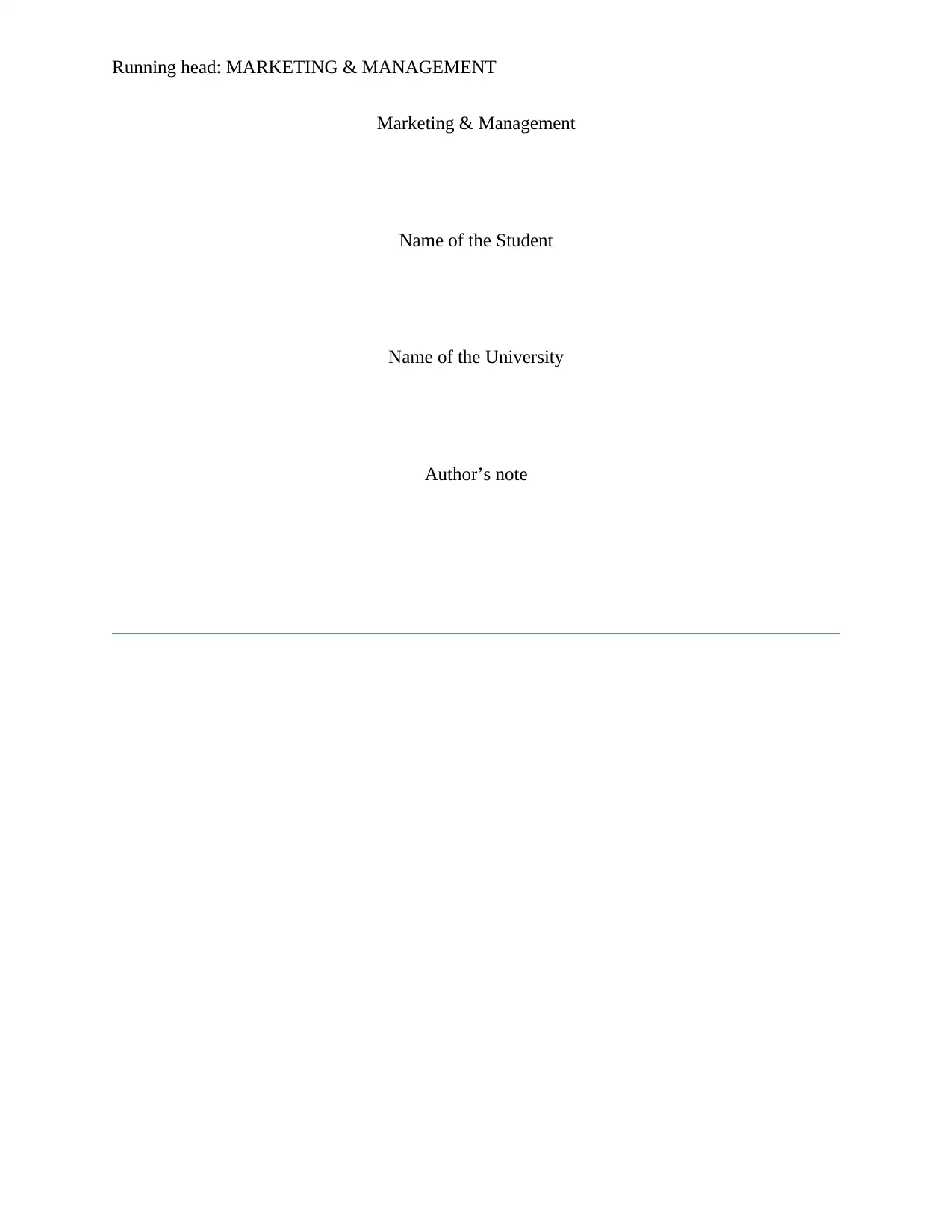
Running head: MARKETING & MANAGEMENT
Marketing & Management
Name of the Student
Name of the University
Author’s note
Marketing & Management
Name of the Student
Name of the University
Author’s note
Paraphrase This Document
Need a fresh take? Get an instant paraphrase of this document with our AI Paraphraser
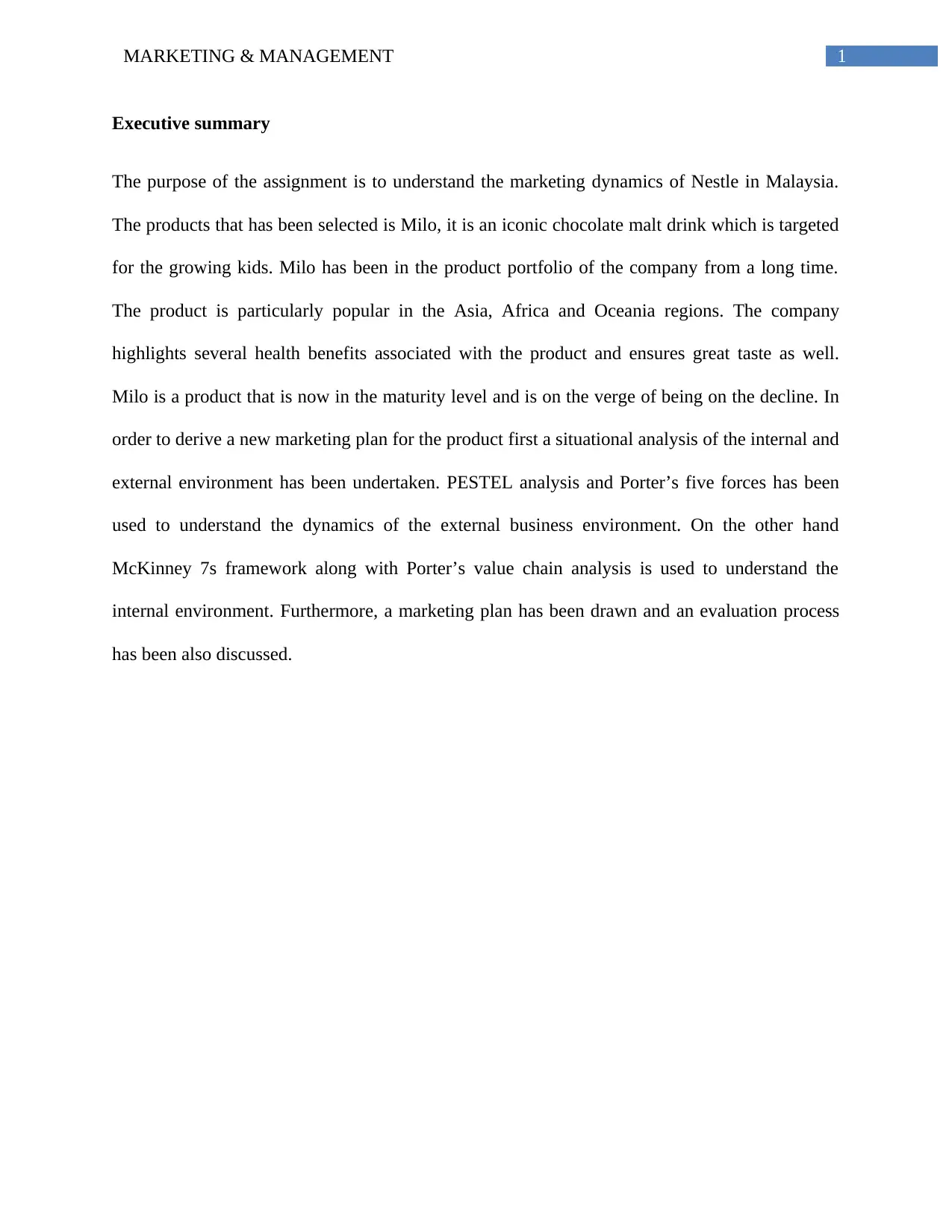
1MARKETING & MANAGEMENT
Executive summary
The purpose of the assignment is to understand the marketing dynamics of Nestle in Malaysia.
The products that has been selected is Milo, it is an iconic chocolate malt drink which is targeted
for the growing kids. Milo has been in the product portfolio of the company from a long time.
The product is particularly popular in the Asia, Africa and Oceania regions. The company
highlights several health benefits associated with the product and ensures great taste as well.
Milo is a product that is now in the maturity level and is on the verge of being on the decline. In
order to derive a new marketing plan for the product first a situational analysis of the internal and
external environment has been undertaken. PESTEL analysis and Porter’s five forces has been
used to understand the dynamics of the external business environment. On the other hand
McKinney 7s framework along with Porter’s value chain analysis is used to understand the
internal environment. Furthermore, a marketing plan has been drawn and an evaluation process
has been also discussed.
Executive summary
The purpose of the assignment is to understand the marketing dynamics of Nestle in Malaysia.
The products that has been selected is Milo, it is an iconic chocolate malt drink which is targeted
for the growing kids. Milo has been in the product portfolio of the company from a long time.
The product is particularly popular in the Asia, Africa and Oceania regions. The company
highlights several health benefits associated with the product and ensures great taste as well.
Milo is a product that is now in the maturity level and is on the verge of being on the decline. In
order to derive a new marketing plan for the product first a situational analysis of the internal and
external environment has been undertaken. PESTEL analysis and Porter’s five forces has been
used to understand the dynamics of the external business environment. On the other hand
McKinney 7s framework along with Porter’s value chain analysis is used to understand the
internal environment. Furthermore, a marketing plan has been drawn and an evaluation process
has been also discussed.
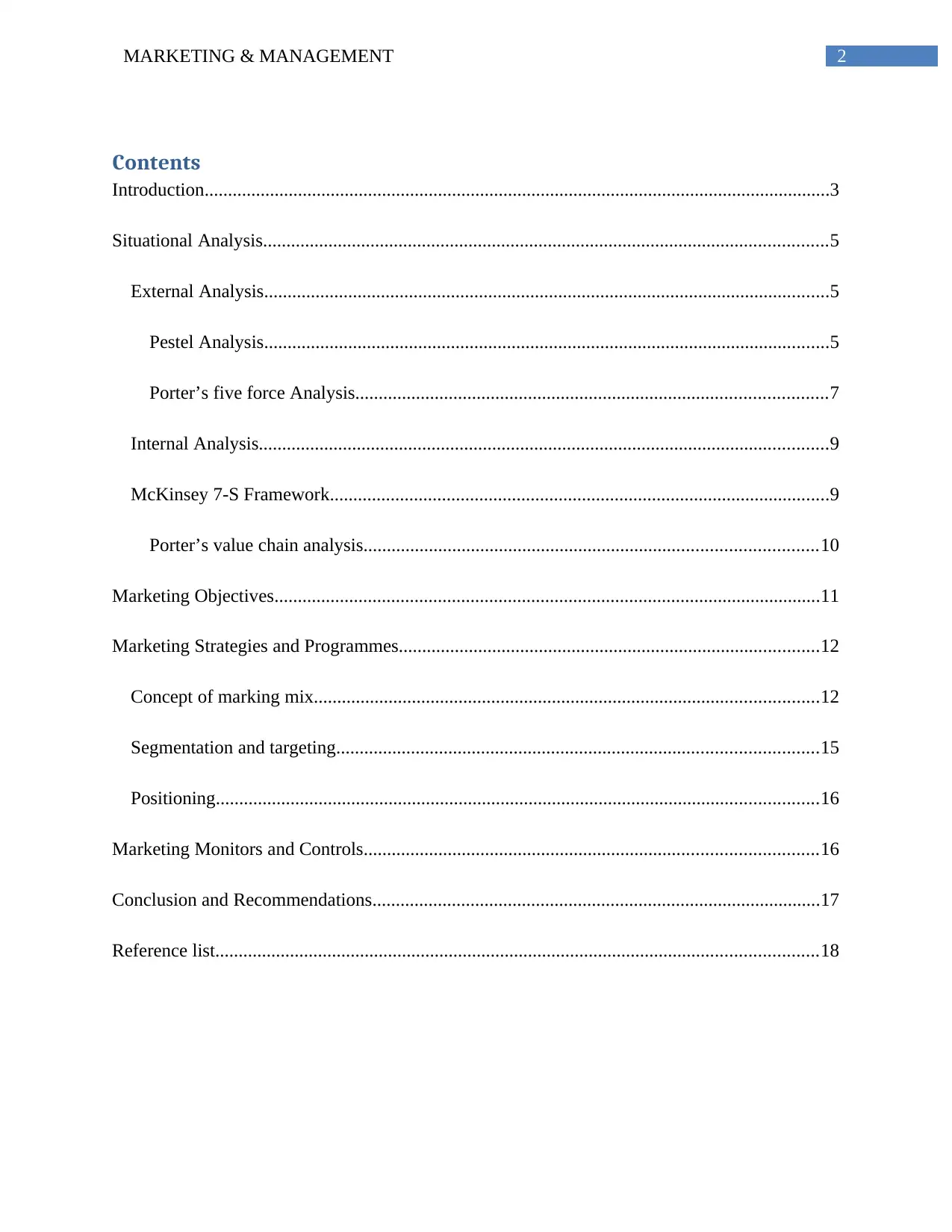
2MARKETING & MANAGEMENT
Contents
Introduction......................................................................................................................................3
Situational Analysis.........................................................................................................................5
External Analysis.........................................................................................................................5
Pestel Analysis.........................................................................................................................5
Porter’s five force Analysis.....................................................................................................7
Internal Analysis..........................................................................................................................9
McKinsey 7-S Framework...........................................................................................................9
Porter’s value chain analysis.................................................................................................10
Marketing Objectives.....................................................................................................................11
Marketing Strategies and Programmes..........................................................................................12
Concept of marking mix............................................................................................................12
Segmentation and targeting.......................................................................................................15
Positioning.................................................................................................................................16
Marketing Monitors and Controls.................................................................................................16
Conclusion and Recommendations................................................................................................17
Reference list.................................................................................................................................18
Contents
Introduction......................................................................................................................................3
Situational Analysis.........................................................................................................................5
External Analysis.........................................................................................................................5
Pestel Analysis.........................................................................................................................5
Porter’s five force Analysis.....................................................................................................7
Internal Analysis..........................................................................................................................9
McKinsey 7-S Framework...........................................................................................................9
Porter’s value chain analysis.................................................................................................10
Marketing Objectives.....................................................................................................................11
Marketing Strategies and Programmes..........................................................................................12
Concept of marking mix............................................................................................................12
Segmentation and targeting.......................................................................................................15
Positioning.................................................................................................................................16
Marketing Monitors and Controls.................................................................................................16
Conclusion and Recommendations................................................................................................17
Reference list.................................................................................................................................18
⊘ This is a preview!⊘
Do you want full access?
Subscribe today to unlock all pages.

Trusted by 1+ million students worldwide
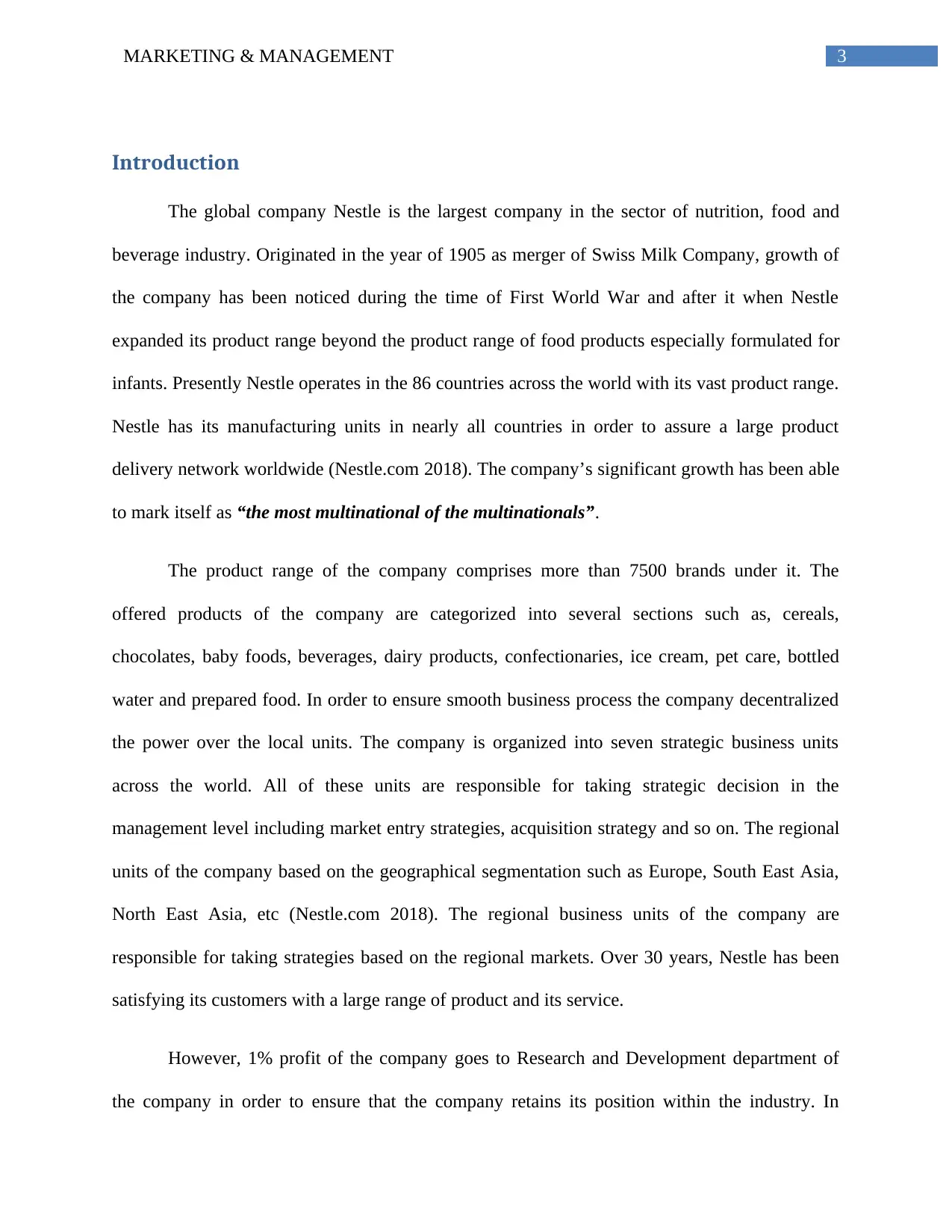
3MARKETING & MANAGEMENT
Introduction
The global company Nestle is the largest company in the sector of nutrition, food and
beverage industry. Originated in the year of 1905 as merger of Swiss Milk Company, growth of
the company has been noticed during the time of First World War and after it when Nestle
expanded its product range beyond the product range of food products especially formulated for
infants. Presently Nestle operates in the 86 countries across the world with its vast product range.
Nestle has its manufacturing units in nearly all countries in order to assure a large product
delivery network worldwide (Nestle.com 2018). The company’s significant growth has been able
to mark itself as “the most multinational of the multinationals”.
The product range of the company comprises more than 7500 brands under it. The
offered products of the company are categorized into several sections such as, cereals,
chocolates, baby foods, beverages, dairy products, confectionaries, ice cream, pet care, bottled
water and prepared food. In order to ensure smooth business process the company decentralized
the power over the local units. The company is organized into seven strategic business units
across the world. All of these units are responsible for taking strategic decision in the
management level including market entry strategies, acquisition strategy and so on. The regional
units of the company based on the geographical segmentation such as Europe, South East Asia,
North East Asia, etc (Nestle.com 2018). The regional business units of the company are
responsible for taking strategies based on the regional markets. Over 30 years, Nestle has been
satisfying its customers with a large range of product and its service.
However, 1% profit of the company goes to Research and Development department of
the company in order to ensure that the company retains its position within the industry. In
Introduction
The global company Nestle is the largest company in the sector of nutrition, food and
beverage industry. Originated in the year of 1905 as merger of Swiss Milk Company, growth of
the company has been noticed during the time of First World War and after it when Nestle
expanded its product range beyond the product range of food products especially formulated for
infants. Presently Nestle operates in the 86 countries across the world with its vast product range.
Nestle has its manufacturing units in nearly all countries in order to assure a large product
delivery network worldwide (Nestle.com 2018). The company’s significant growth has been able
to mark itself as “the most multinational of the multinationals”.
The product range of the company comprises more than 7500 brands under it. The
offered products of the company are categorized into several sections such as, cereals,
chocolates, baby foods, beverages, dairy products, confectionaries, ice cream, pet care, bottled
water and prepared food. In order to ensure smooth business process the company decentralized
the power over the local units. The company is organized into seven strategic business units
across the world. All of these units are responsible for taking strategic decision in the
management level including market entry strategies, acquisition strategy and so on. The regional
units of the company based on the geographical segmentation such as Europe, South East Asia,
North East Asia, etc (Nestle.com 2018). The regional business units of the company are
responsible for taking strategies based on the regional markets. Over 30 years, Nestle has been
satisfying its customers with a large range of product and its service.
However, 1% profit of the company goes to Research and Development department of
the company in order to ensure that the company retains its position within the industry. In
Paraphrase This Document
Need a fresh take? Get an instant paraphrase of this document with our AI Paraphraser
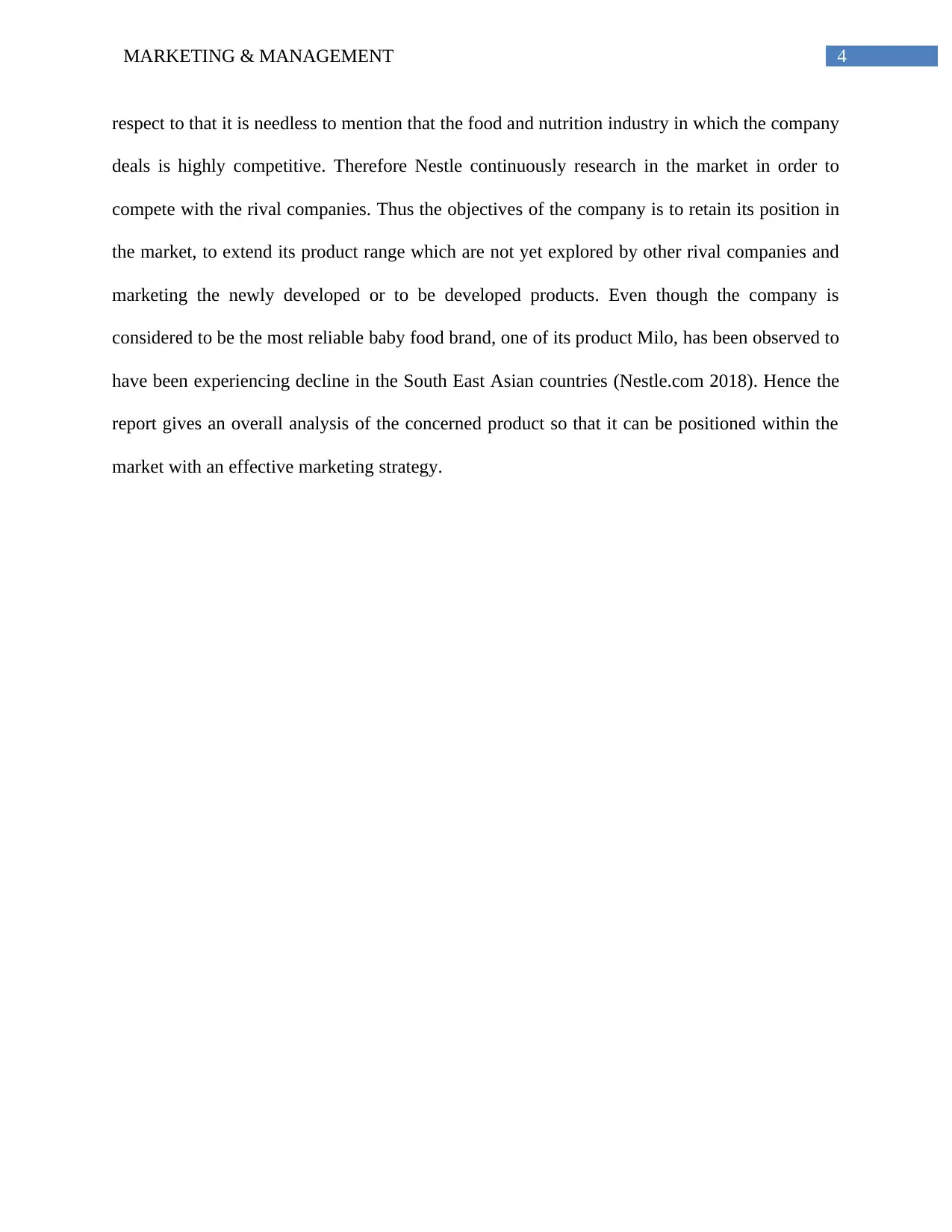
4MARKETING & MANAGEMENT
respect to that it is needless to mention that the food and nutrition industry in which the company
deals is highly competitive. Therefore Nestle continuously research in the market in order to
compete with the rival companies. Thus the objectives of the company is to retain its position in
the market, to extend its product range which are not yet explored by other rival companies and
marketing the newly developed or to be developed products. Even though the company is
considered to be the most reliable baby food brand, one of its product Milo, has been observed to
have been experiencing decline in the South East Asian countries (Nestle.com 2018). Hence the
report gives an overall analysis of the concerned product so that it can be positioned within the
market with an effective marketing strategy.
respect to that it is needless to mention that the food and nutrition industry in which the company
deals is highly competitive. Therefore Nestle continuously research in the market in order to
compete with the rival companies. Thus the objectives of the company is to retain its position in
the market, to extend its product range which are not yet explored by other rival companies and
marketing the newly developed or to be developed products. Even though the company is
considered to be the most reliable baby food brand, one of its product Milo, has been observed to
have been experiencing decline in the South East Asian countries (Nestle.com 2018). Hence the
report gives an overall analysis of the concerned product so that it can be positioned within the
market with an effective marketing strategy.
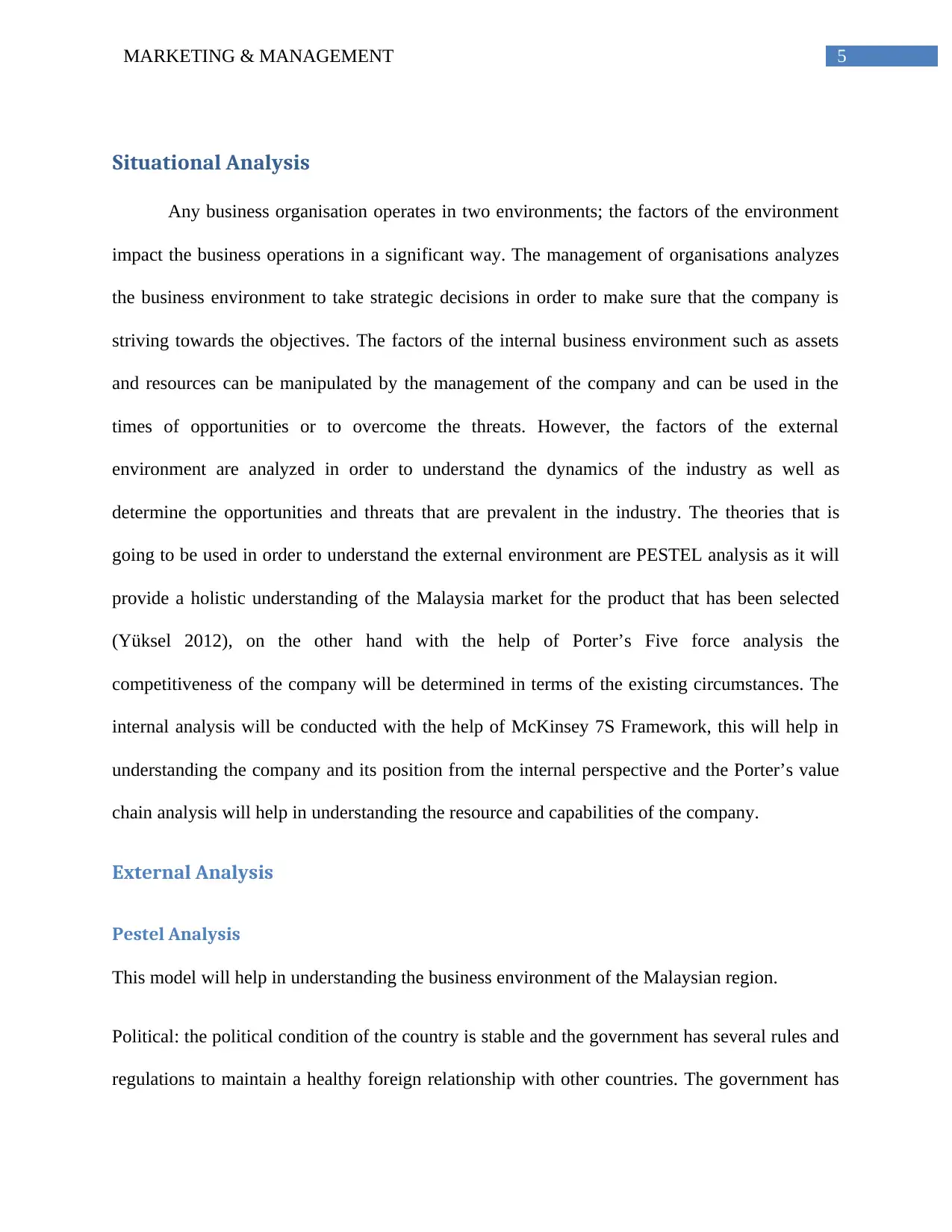
5MARKETING & MANAGEMENT
Situational Analysis
Any business organisation operates in two environments; the factors of the environment
impact the business operations in a significant way. The management of organisations analyzes
the business environment to take strategic decisions in order to make sure that the company is
striving towards the objectives. The factors of the internal business environment such as assets
and resources can be manipulated by the management of the company and can be used in the
times of opportunities or to overcome the threats. However, the factors of the external
environment are analyzed in order to understand the dynamics of the industry as well as
determine the opportunities and threats that are prevalent in the industry. The theories that is
going to be used in order to understand the external environment are PESTEL analysis as it will
provide a holistic understanding of the Malaysia market for the product that has been selected
(Yüksel 2012), on the other hand with the help of Porter’s Five force analysis the
competitiveness of the company will be determined in terms of the existing circumstances. The
internal analysis will be conducted with the help of McKinsey 7S Framework, this will help in
understanding the company and its position from the internal perspective and the Porter’s value
chain analysis will help in understanding the resource and capabilities of the company.
External Analysis
Pestel Analysis
This model will help in understanding the business environment of the Malaysian region.
Political: the political condition of the country is stable and the government has several rules and
regulations to maintain a healthy foreign relationship with other countries. The government has
Situational Analysis
Any business organisation operates in two environments; the factors of the environment
impact the business operations in a significant way. The management of organisations analyzes
the business environment to take strategic decisions in order to make sure that the company is
striving towards the objectives. The factors of the internal business environment such as assets
and resources can be manipulated by the management of the company and can be used in the
times of opportunities or to overcome the threats. However, the factors of the external
environment are analyzed in order to understand the dynamics of the industry as well as
determine the opportunities and threats that are prevalent in the industry. The theories that is
going to be used in order to understand the external environment are PESTEL analysis as it will
provide a holistic understanding of the Malaysia market for the product that has been selected
(Yüksel 2012), on the other hand with the help of Porter’s Five force analysis the
competitiveness of the company will be determined in terms of the existing circumstances. The
internal analysis will be conducted with the help of McKinsey 7S Framework, this will help in
understanding the company and its position from the internal perspective and the Porter’s value
chain analysis will help in understanding the resource and capabilities of the company.
External Analysis
Pestel Analysis
This model will help in understanding the business environment of the Malaysian region.
Political: the political condition of the country is stable and the government has several rules and
regulations to maintain a healthy foreign relationship with other countries. The government has
⊘ This is a preview!⊘
Do you want full access?
Subscribe today to unlock all pages.

Trusted by 1+ million students worldwide
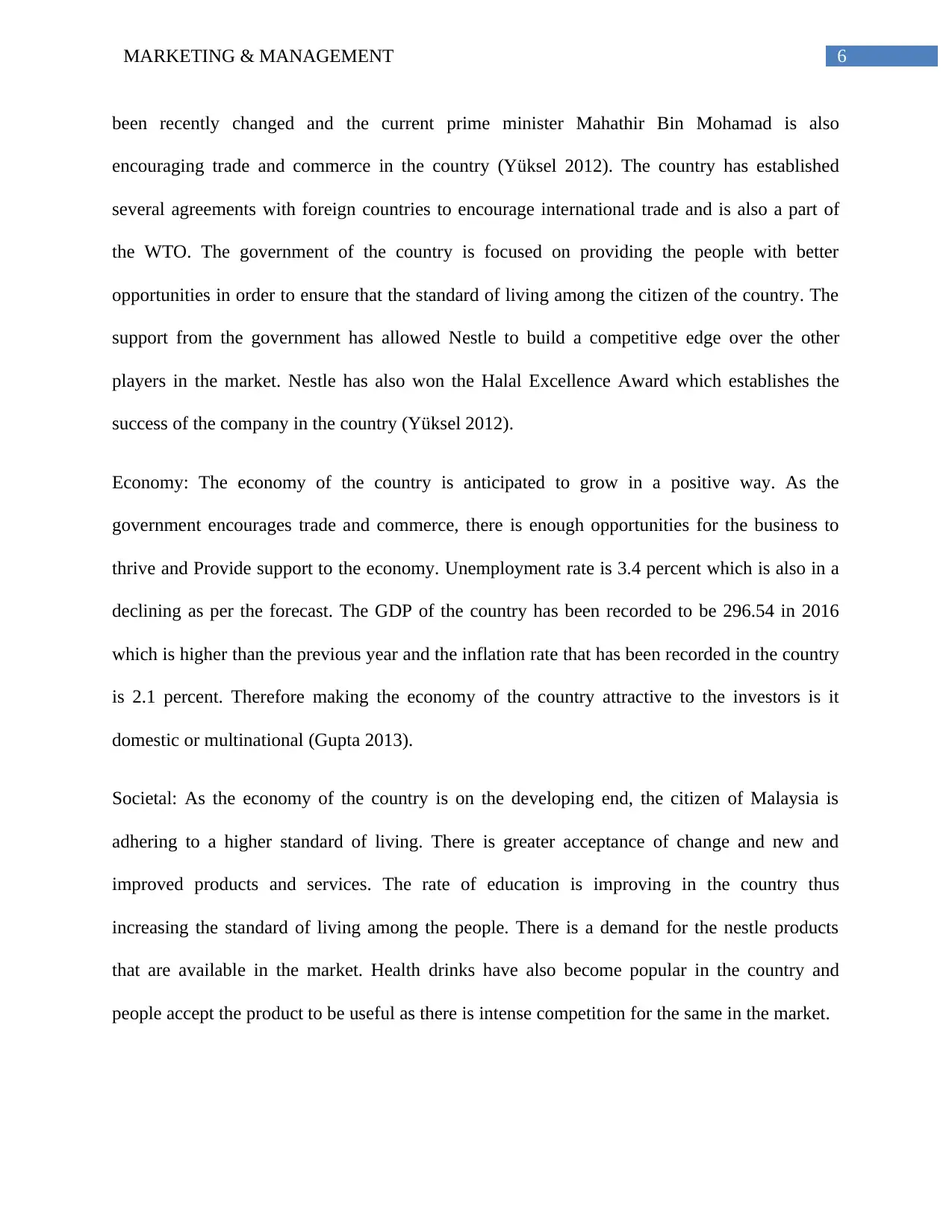
6MARKETING & MANAGEMENT
been recently changed and the current prime minister Mahathir Bin Mohamad is also
encouraging trade and commerce in the country (Yüksel 2012). The country has established
several agreements with foreign countries to encourage international trade and is also a part of
the WTO. The government of the country is focused on providing the people with better
opportunities in order to ensure that the standard of living among the citizen of the country. The
support from the government has allowed Nestle to build a competitive edge over the other
players in the market. Nestle has also won the Halal Excellence Award which establishes the
success of the company in the country (Yüksel 2012).
Economy: The economy of the country is anticipated to grow in a positive way. As the
government encourages trade and commerce, there is enough opportunities for the business to
thrive and Provide support to the economy. Unemployment rate is 3.4 percent which is also in a
declining as per the forecast. The GDP of the country has been recorded to be 296.54 in 2016
which is higher than the previous year and the inflation rate that has been recorded in the country
is 2.1 percent. Therefore making the economy of the country attractive to the investors is it
domestic or multinational (Gupta 2013).
Societal: As the economy of the country is on the developing end, the citizen of Malaysia is
adhering to a higher standard of living. There is greater acceptance of change and new and
improved products and services. The rate of education is improving in the country thus
increasing the standard of living among the people. There is a demand for the nestle products
that are available in the market. Health drinks have also become popular in the country and
people accept the product to be useful as there is intense competition for the same in the market.
been recently changed and the current prime minister Mahathir Bin Mohamad is also
encouraging trade and commerce in the country (Yüksel 2012). The country has established
several agreements with foreign countries to encourage international trade and is also a part of
the WTO. The government of the country is focused on providing the people with better
opportunities in order to ensure that the standard of living among the citizen of the country. The
support from the government has allowed Nestle to build a competitive edge over the other
players in the market. Nestle has also won the Halal Excellence Award which establishes the
success of the company in the country (Yüksel 2012).
Economy: The economy of the country is anticipated to grow in a positive way. As the
government encourages trade and commerce, there is enough opportunities for the business to
thrive and Provide support to the economy. Unemployment rate is 3.4 percent which is also in a
declining as per the forecast. The GDP of the country has been recorded to be 296.54 in 2016
which is higher than the previous year and the inflation rate that has been recorded in the country
is 2.1 percent. Therefore making the economy of the country attractive to the investors is it
domestic or multinational (Gupta 2013).
Societal: As the economy of the country is on the developing end, the citizen of Malaysia is
adhering to a higher standard of living. There is greater acceptance of change and new and
improved products and services. The rate of education is improving in the country thus
increasing the standard of living among the people. There is a demand for the nestle products
that are available in the market. Health drinks have also become popular in the country and
people accept the product to be useful as there is intense competition for the same in the market.
Paraphrase This Document
Need a fresh take? Get an instant paraphrase of this document with our AI Paraphraser
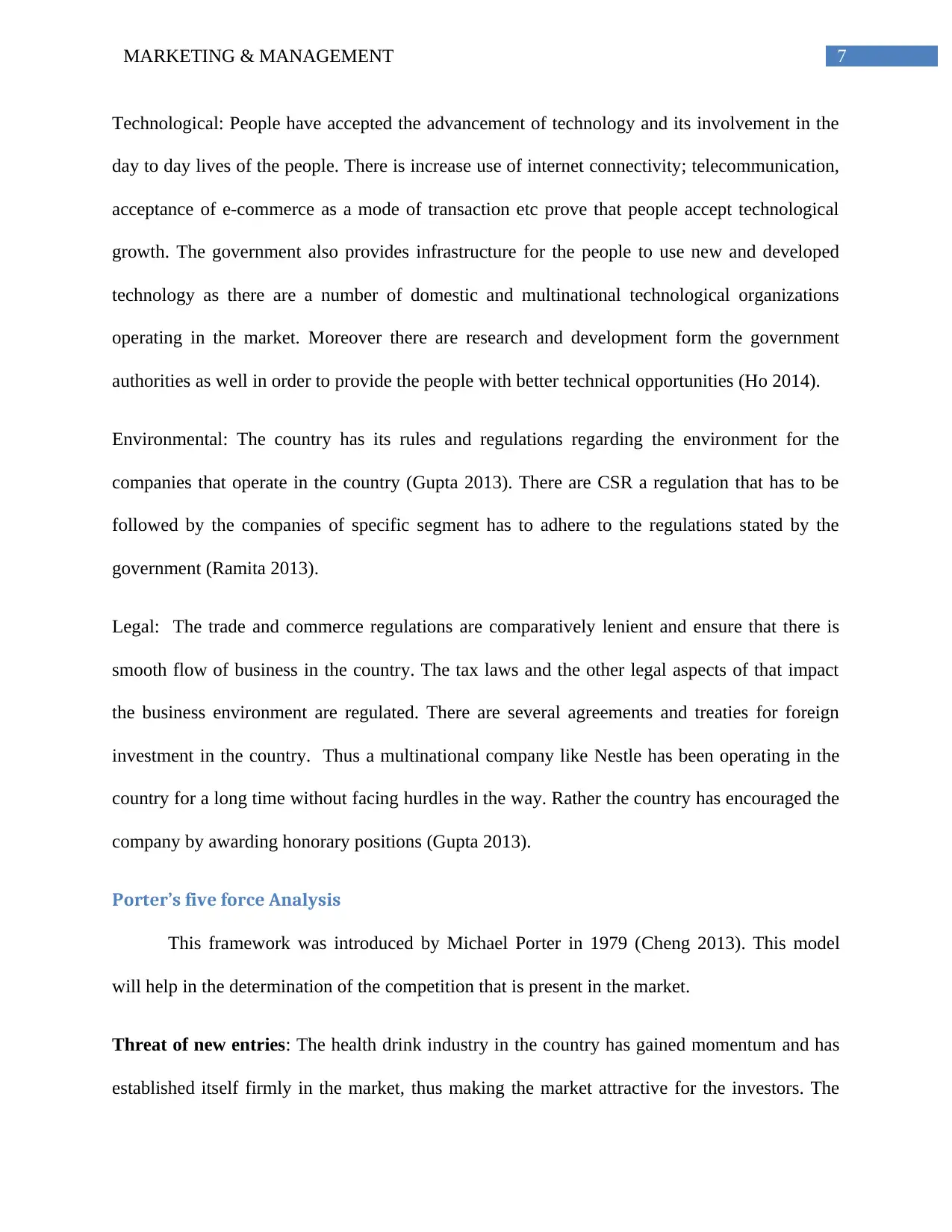
7MARKETING & MANAGEMENT
Technological: People have accepted the advancement of technology and its involvement in the
day to day lives of the people. There is increase use of internet connectivity; telecommunication,
acceptance of e-commerce as a mode of transaction etc prove that people accept technological
growth. The government also provides infrastructure for the people to use new and developed
technology as there are a number of domestic and multinational technological organizations
operating in the market. Moreover there are research and development form the government
authorities as well in order to provide the people with better technical opportunities (Ho 2014).
Environmental: The country has its rules and regulations regarding the environment for the
companies that operate in the country (Gupta 2013). There are CSR a regulation that has to be
followed by the companies of specific segment has to adhere to the regulations stated by the
government (Ramita 2013).
Legal: The trade and commerce regulations are comparatively lenient and ensure that there is
smooth flow of business in the country. The tax laws and the other legal aspects of that impact
the business environment are regulated. There are several agreements and treaties for foreign
investment in the country. Thus a multinational company like Nestle has been operating in the
country for a long time without facing hurdles in the way. Rather the country has encouraged the
company by awarding honorary positions (Gupta 2013).
Porter’s five force Analysis
This framework was introduced by Michael Porter in 1979 (Cheng 2013). This model
will help in the determination of the competition that is present in the market.
Threat of new entries: The health drink industry in the country has gained momentum and has
established itself firmly in the market, thus making the market attractive for the investors. The
Technological: People have accepted the advancement of technology and its involvement in the
day to day lives of the people. There is increase use of internet connectivity; telecommunication,
acceptance of e-commerce as a mode of transaction etc prove that people accept technological
growth. The government also provides infrastructure for the people to use new and developed
technology as there are a number of domestic and multinational technological organizations
operating in the market. Moreover there are research and development form the government
authorities as well in order to provide the people with better technical opportunities (Ho 2014).
Environmental: The country has its rules and regulations regarding the environment for the
companies that operate in the country (Gupta 2013). There are CSR a regulation that has to be
followed by the companies of specific segment has to adhere to the regulations stated by the
government (Ramita 2013).
Legal: The trade and commerce regulations are comparatively lenient and ensure that there is
smooth flow of business in the country. The tax laws and the other legal aspects of that impact
the business environment are regulated. There are several agreements and treaties for foreign
investment in the country. Thus a multinational company like Nestle has been operating in the
country for a long time without facing hurdles in the way. Rather the country has encouraged the
company by awarding honorary positions (Gupta 2013).
Porter’s five force Analysis
This framework was introduced by Michael Porter in 1979 (Cheng 2013). This model
will help in the determination of the competition that is present in the market.
Threat of new entries: The health drink industry in the country has gained momentum and has
established itself firmly in the market, thus making the market attractive for the investors. The
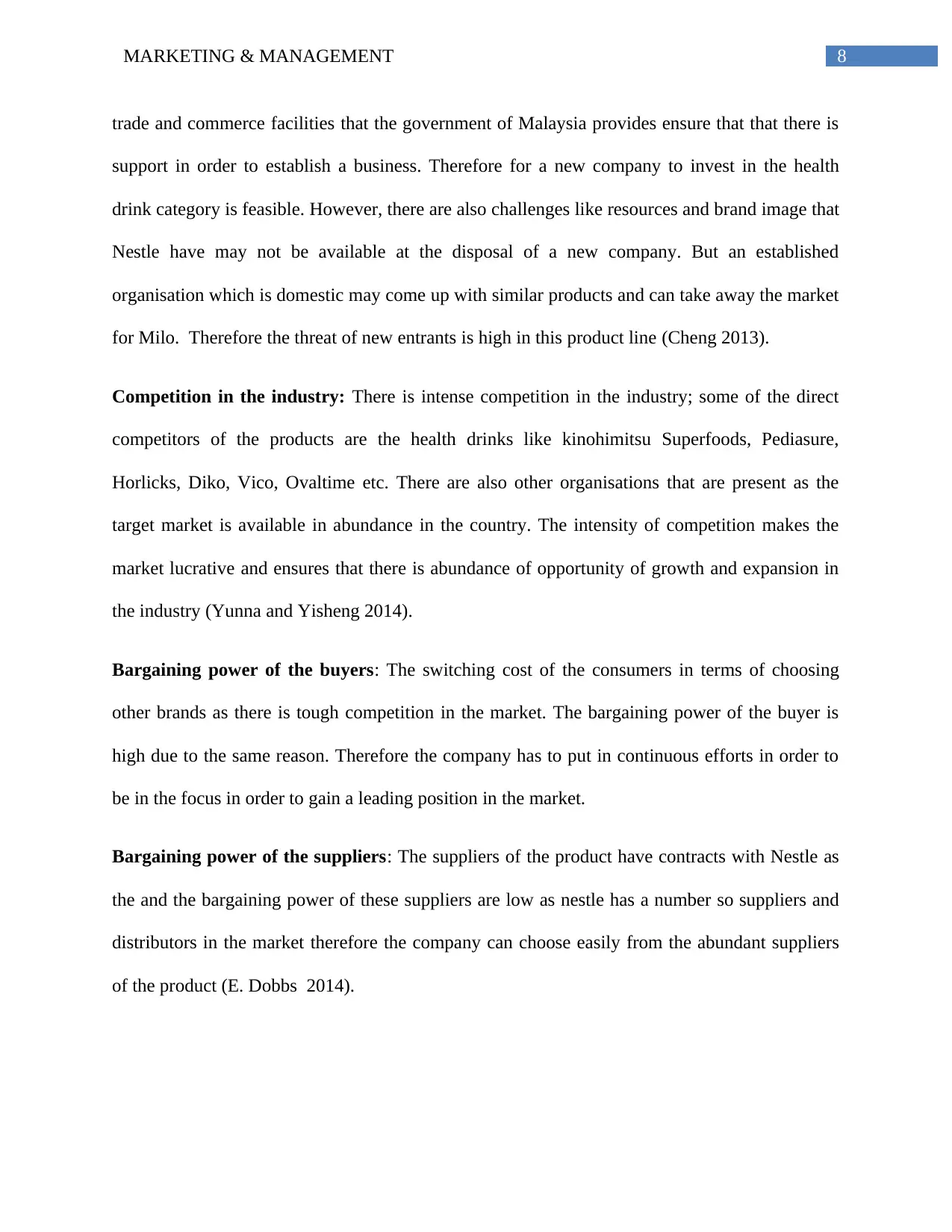
8MARKETING & MANAGEMENT
trade and commerce facilities that the government of Malaysia provides ensure that that there is
support in order to establish a business. Therefore for a new company to invest in the health
drink category is feasible. However, there are also challenges like resources and brand image that
Nestle have may not be available at the disposal of a new company. But an established
organisation which is domestic may come up with similar products and can take away the market
for Milo. Therefore the threat of new entrants is high in this product line (Cheng 2013).
Competition in the industry: There is intense competition in the industry; some of the direct
competitors of the products are the health drinks like kinohimitsu Superfoods, Pediasure,
Horlicks, Diko, Vico, Ovaltime etc. There are also other organisations that are present as the
target market is available in abundance in the country. The intensity of competition makes the
market lucrative and ensures that there is abundance of opportunity of growth and expansion in
the industry (Yunna and Yisheng 2014).
Bargaining power of the buyers: The switching cost of the consumers in terms of choosing
other brands as there is tough competition in the market. The bargaining power of the buyer is
high due to the same reason. Therefore the company has to put in continuous efforts in order to
be in the focus in order to gain a leading position in the market.
Bargaining power of the suppliers: The suppliers of the product have contracts with Nestle as
the and the bargaining power of these suppliers are low as nestle has a number so suppliers and
distributors in the market therefore the company can choose easily from the abundant suppliers
of the product (E. Dobbs 2014).
trade and commerce facilities that the government of Malaysia provides ensure that that there is
support in order to establish a business. Therefore for a new company to invest in the health
drink category is feasible. However, there are also challenges like resources and brand image that
Nestle have may not be available at the disposal of a new company. But an established
organisation which is domestic may come up with similar products and can take away the market
for Milo. Therefore the threat of new entrants is high in this product line (Cheng 2013).
Competition in the industry: There is intense competition in the industry; some of the direct
competitors of the products are the health drinks like kinohimitsu Superfoods, Pediasure,
Horlicks, Diko, Vico, Ovaltime etc. There are also other organisations that are present as the
target market is available in abundance in the country. The intensity of competition makes the
market lucrative and ensures that there is abundance of opportunity of growth and expansion in
the industry (Yunna and Yisheng 2014).
Bargaining power of the buyers: The switching cost of the consumers in terms of choosing
other brands as there is tough competition in the market. The bargaining power of the buyer is
high due to the same reason. Therefore the company has to put in continuous efforts in order to
be in the focus in order to gain a leading position in the market.
Bargaining power of the suppliers: The suppliers of the product have contracts with Nestle as
the and the bargaining power of these suppliers are low as nestle has a number so suppliers and
distributors in the market therefore the company can choose easily from the abundant suppliers
of the product (E. Dobbs 2014).
⊘ This is a preview!⊘
Do you want full access?
Subscribe today to unlock all pages.

Trusted by 1+ million students worldwide
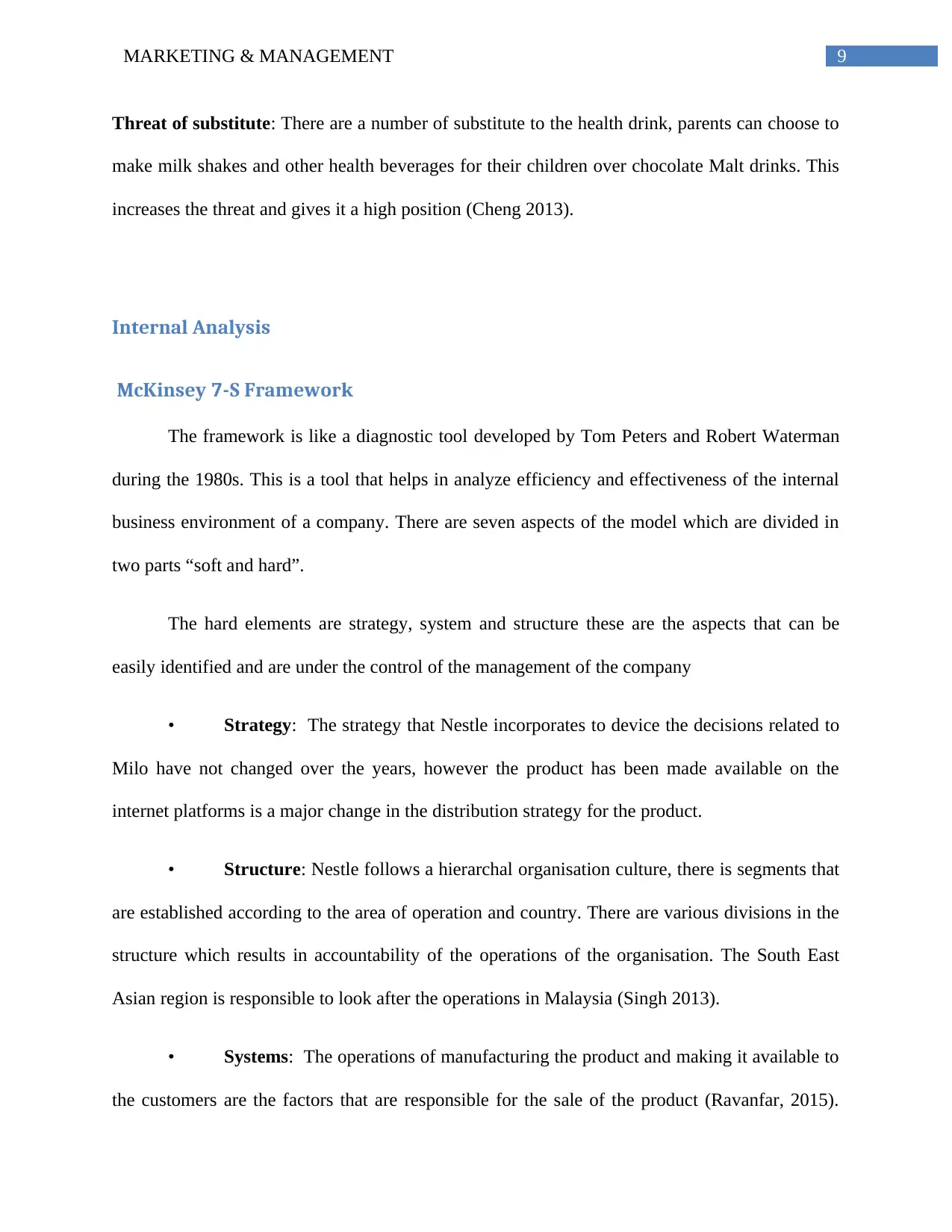
9MARKETING & MANAGEMENT
Threat of substitute: There are a number of substitute to the health drink, parents can choose to
make milk shakes and other health beverages for their children over chocolate Malt drinks. This
increases the threat and gives it a high position (Cheng 2013).
Internal Analysis
McKinsey 7-S Framework
The framework is like a diagnostic tool developed by Tom Peters and Robert Waterman
during the 1980s. This is a tool that helps in analyze efficiency and effectiveness of the internal
business environment of a company. There are seven aspects of the model which are divided in
two parts “soft and hard”.
The hard elements are strategy, system and structure these are the aspects that can be
easily identified and are under the control of the management of the company
• Strategy: The strategy that Nestle incorporates to device the decisions related to
Milo have not changed over the years, however the product has been made available on the
internet platforms is a major change in the distribution strategy for the product.
• Structure: Nestle follows a hierarchal organisation culture, there is segments that
are established according to the area of operation and country. There are various divisions in the
structure which results in accountability of the operations of the organisation. The South East
Asian region is responsible to look after the operations in Malaysia (Singh 2013).
• Systems: The operations of manufacturing the product and making it available to
the customers are the factors that are responsible for the sale of the product (Ravanfar, 2015).
Threat of substitute: There are a number of substitute to the health drink, parents can choose to
make milk shakes and other health beverages for their children over chocolate Malt drinks. This
increases the threat and gives it a high position (Cheng 2013).
Internal Analysis
McKinsey 7-S Framework
The framework is like a diagnostic tool developed by Tom Peters and Robert Waterman
during the 1980s. This is a tool that helps in analyze efficiency and effectiveness of the internal
business environment of a company. There are seven aspects of the model which are divided in
two parts “soft and hard”.
The hard elements are strategy, system and structure these are the aspects that can be
easily identified and are under the control of the management of the company
• Strategy: The strategy that Nestle incorporates to device the decisions related to
Milo have not changed over the years, however the product has been made available on the
internet platforms is a major change in the distribution strategy for the product.
• Structure: Nestle follows a hierarchal organisation culture, there is segments that
are established according to the area of operation and country. There are various divisions in the
structure which results in accountability of the operations of the organisation. The South East
Asian region is responsible to look after the operations in Malaysia (Singh 2013).
• Systems: The operations of manufacturing the product and making it available to
the customers are the factors that are responsible for the sale of the product (Ravanfar, 2015).
Paraphrase This Document
Need a fresh take? Get an instant paraphrase of this document with our AI Paraphraser
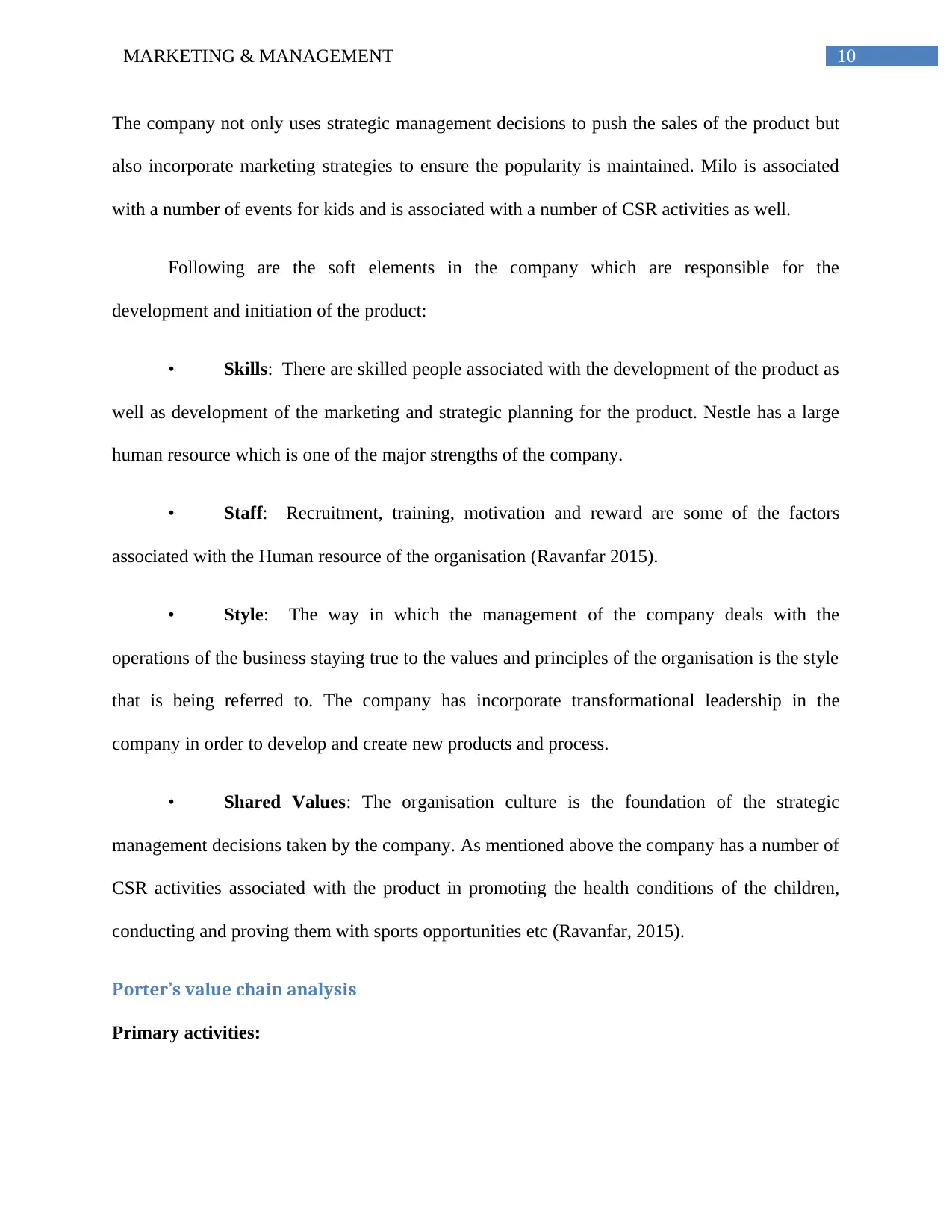
10MARKETING & MANAGEMENT
The company not only uses strategic management decisions to push the sales of the product but
also incorporate marketing strategies to ensure the popularity is maintained. Milo is associated
with a number of events for kids and is associated with a number of CSR activities as well.
Following are the soft elements in the company which are responsible for the
development and initiation of the product:
• Skills: There are skilled people associated with the development of the product as
well as development of the marketing and strategic planning for the product. Nestle has a large
human resource which is one of the major strengths of the company.
• Staff: Recruitment, training, motivation and reward are some of the factors
associated with the Human resource of the organisation (Ravanfar 2015).
• Style: The way in which the management of the company deals with the
operations of the business staying true to the values and principles of the organisation is the style
that is being referred to. The company has incorporate transformational leadership in the
company in order to develop and create new products and process.
• Shared Values: The organisation culture is the foundation of the strategic
management decisions taken by the company. As mentioned above the company has a number of
CSR activities associated with the product in promoting the health conditions of the children,
conducting and proving them with sports opportunities etc (Ravanfar, 2015).
Porter’s value chain analysis
Primary activities:
The company not only uses strategic management decisions to push the sales of the product but
also incorporate marketing strategies to ensure the popularity is maintained. Milo is associated
with a number of events for kids and is associated with a number of CSR activities as well.
Following are the soft elements in the company which are responsible for the
development and initiation of the product:
• Skills: There are skilled people associated with the development of the product as
well as development of the marketing and strategic planning for the product. Nestle has a large
human resource which is one of the major strengths of the company.
• Staff: Recruitment, training, motivation and reward are some of the factors
associated with the Human resource of the organisation (Ravanfar 2015).
• Style: The way in which the management of the company deals with the
operations of the business staying true to the values and principles of the organisation is the style
that is being referred to. The company has incorporate transformational leadership in the
company in order to develop and create new products and process.
• Shared Values: The organisation culture is the foundation of the strategic
management decisions taken by the company. As mentioned above the company has a number of
CSR activities associated with the product in promoting the health conditions of the children,
conducting and proving them with sports opportunities etc (Ravanfar, 2015).
Porter’s value chain analysis
Primary activities:
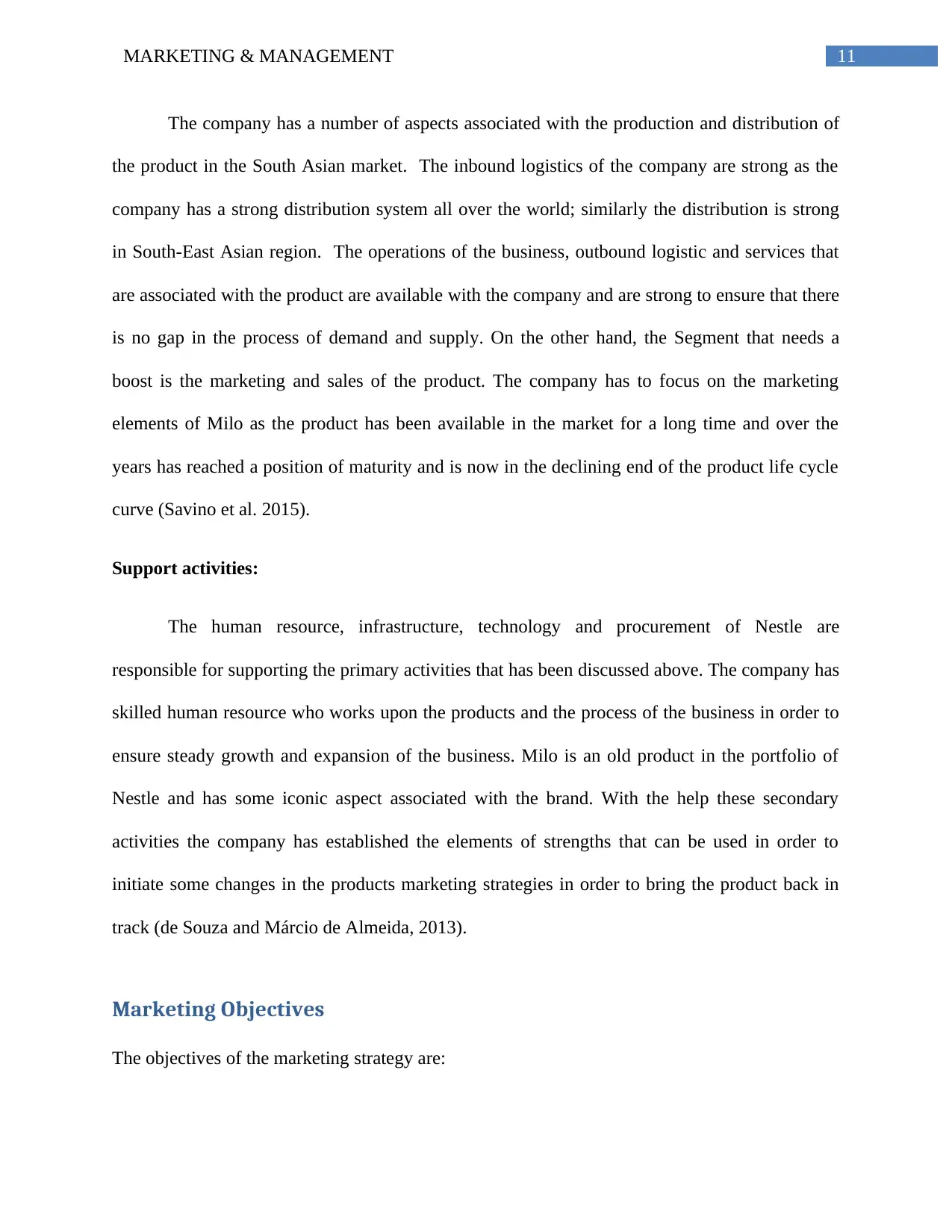
11MARKETING & MANAGEMENT
The company has a number of aspects associated with the production and distribution of
the product in the South Asian market. The inbound logistics of the company are strong as the
company has a strong distribution system all over the world; similarly the distribution is strong
in South-East Asian region. The operations of the business, outbound logistic and services that
are associated with the product are available with the company and are strong to ensure that there
is no gap in the process of demand and supply. On the other hand, the Segment that needs a
boost is the marketing and sales of the product. The company has to focus on the marketing
elements of Milo as the product has been available in the market for a long time and over the
years has reached a position of maturity and is now in the declining end of the product life cycle
curve (Savino et al. 2015).
Support activities:
The human resource, infrastructure, technology and procurement of Nestle are
responsible for supporting the primary activities that has been discussed above. The company has
skilled human resource who works upon the products and the process of the business in order to
ensure steady growth and expansion of the business. Milo is an old product in the portfolio of
Nestle and has some iconic aspect associated with the brand. With the help these secondary
activities the company has established the elements of strengths that can be used in order to
initiate some changes in the products marketing strategies in order to bring the product back in
track (de Souza and Márcio de Almeida, 2013).
Marketing Objectives
The objectives of the marketing strategy are:
The company has a number of aspects associated with the production and distribution of
the product in the South Asian market. The inbound logistics of the company are strong as the
company has a strong distribution system all over the world; similarly the distribution is strong
in South-East Asian region. The operations of the business, outbound logistic and services that
are associated with the product are available with the company and are strong to ensure that there
is no gap in the process of demand and supply. On the other hand, the Segment that needs a
boost is the marketing and sales of the product. The company has to focus on the marketing
elements of Milo as the product has been available in the market for a long time and over the
years has reached a position of maturity and is now in the declining end of the product life cycle
curve (Savino et al. 2015).
Support activities:
The human resource, infrastructure, technology and procurement of Nestle are
responsible for supporting the primary activities that has been discussed above. The company has
skilled human resource who works upon the products and the process of the business in order to
ensure steady growth and expansion of the business. Milo is an old product in the portfolio of
Nestle and has some iconic aspect associated with the brand. With the help these secondary
activities the company has established the elements of strengths that can be used in order to
initiate some changes in the products marketing strategies in order to bring the product back in
track (de Souza and Márcio de Almeida, 2013).
Marketing Objectives
The objectives of the marketing strategy are:
⊘ This is a preview!⊘
Do you want full access?
Subscribe today to unlock all pages.

Trusted by 1+ million students worldwide
1 out of 21
Related Documents
Your All-in-One AI-Powered Toolkit for Academic Success.
+13062052269
info@desklib.com
Available 24*7 on WhatsApp / Email
![[object Object]](/_next/static/media/star-bottom.7253800d.svg)
Unlock your academic potential
Copyright © 2020–2025 A2Z Services. All Rights Reserved. Developed and managed by ZUCOL.





